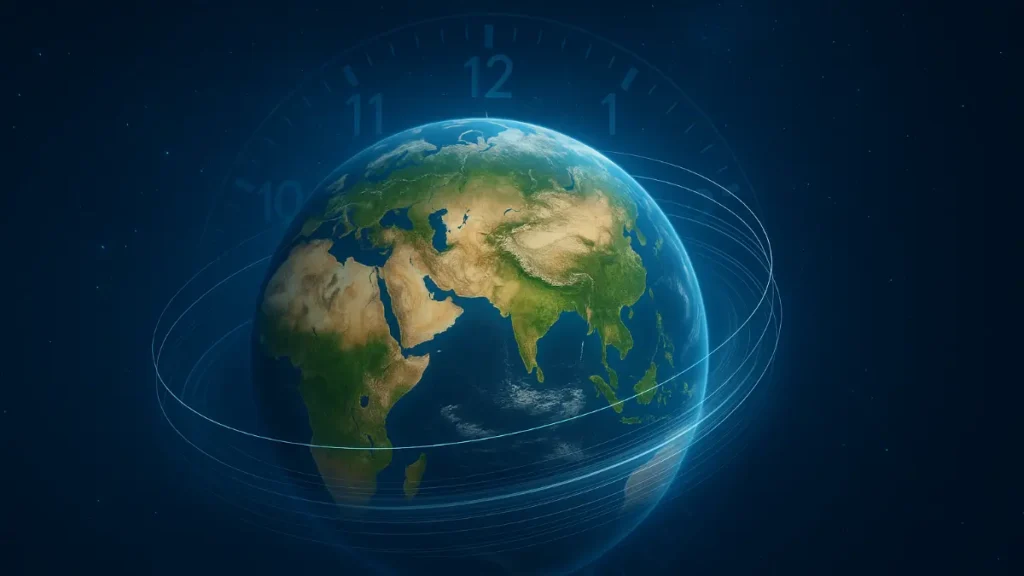Earth’s Record-Breaking Rotation in 2025
In July and August 2025, Earth recorded some of the shortest days ever observed. On July 9, July 22, and August 5, the planet completed its rotation 1.3 to 1.51 milliseconds faster than the standard 24-hour day.
This change is invisible to humans but critical for scientists, satellites, and timekeeping systems. Precision data from atomic clocks and satellite tracking confirmed these subtle shifts in Earth’s rotation.
Why Is Earth Spinning Faster?
The Moon’s Gravitational Influence
One of the main causes behind 2025’s rapid rotations is the Moon’s position relative to Earth’s equator. When the Moon reaches its highest declination, meaning it is farthest north or south from the equator, its gravitational pull creates a slight axial shift. This subtle adjustment affects Earth’s balance and allows it to spin slightly faster than usual.
Atmospheric and Oceanic Patterns
Wind currents, ocean circulation, and pressure changes constantly redistribute Earth’s mass. Events like El Niño, intense storms, and high-altitude jet streams can lead to temporary changes in Earth’s rotation speed.
Movements Within the Earth
Deep internal shifts, such as tectonic plate movements, earthquakes, or magma flows, can transfer momentum within Earth. While these are usually minor in the short term, they still influence the planet’s spin.
Mass Redistribution From Climate Change
As glaciers and polar ice caps melt, mass shifts from high latitudes to the equator. This typically slows Earth’s spin. However, short-term accelerators like atmospheric dynamics have overpowered this effect in recent years, resulting in temporary faster rotations.
Why Do These Milliseconds Matter?
Though unnoticeable in daily life, these millisecond-level changes have big consequences:
- Precise synchronization of atomic clocks and UTC (Coordinated Universal Time)
- Accuracy of satellite systems like GPS and GNSS
- Timing in financial transactions, servers, and internet infrastructure
- Astronomical measurements and scientific experiments
Small discrepancies, if left unchecked, can accumulate and disrupt global systems.
Could a Negative Leap Second Be Coming?
The International Earth Rotation and Reference Systems Service (IERS) has long added positive leap seconds to keep UTC in sync with Earth’s natural rotation. But due to Earth’s faster spin, we may soon face a historic first: the need for a negative leap second, possibly as early as 2029.
This would involve removing one second from global timekeeping, a step that has never been taken before. It could present technical challenges for computer networks, time-sensitive systems, and worldwide communication infrastructure.
Earth’s Long-Term Rotation Trends
Despite these recent fast days, the long-term trend is gradual slowing. Tidal friction caused by the Moon increases the day length by about 2 milliseconds per century.
- During the dinosaur era, a day was under 23 hours
- Historical records, including ancient eclipses, confirm this steady increase over time
- Earth’s current speed-up is a short-term fluctuation overlaid on a long-term slow-down
Final Thoughts
- Earth’s shortest days on record occurred in July and August 2025, with up to 1.51 milliseconds shaved off the standard day
- The cause is a mix of lunar gravity, atmospheric circulation, internal dynamics, and climate-related mass shifts
- While invisible to our senses, these changes are critical for precise timekeeping and global systems
- A negative leap second may be required by 2029, marking a significant milestone in time management across the world
Sources & References
- Space.com: Earth just had one of its shortest days ever and 2 more are coming
- Sky at Night Magazine: Today is the shortest day in our planet’s history
- Moneycontrol: Earth is spinning faster, bringing the shortest days ahead
👉 Explore more posts in Tech Explained



